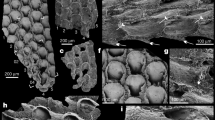Abstract
IT is to be regretted that Dr. Bidder (NATURE, February 28), before publishing his criticisms of my theory of the symbiotic origin of sponge-spicules, did not await the publication of the detailed evidence upon which that theory is based. I am loth to enter into controversy with him, but as his letter contains much that is misleading, I feel that I can scarcely pass it over in silence. He speaks of the observation (presumably mine) “that the first rudiment of the spicule in Stelletta is a skeleton-crystal on the tetra-hedral system.” I made no such observation. On the contrary, I endeavoured to show by observations on the silica pearls that the first rudiment is a minute granule resembling a Micrococcus.
This is a preview of subscription content, access via your institution
Access options
Subscribe to this journal
Receive 51 print issues and online access
$199.00 per year
only $3.90 per issue
Buy this article
- Purchase on Springer Link
- Instant access to full article PDF
Prices may be subject to local taxes which are calculated during checkout
Similar content being viewed by others
Author information
Authors and Affiliations
Rights and permissions
About this article
Cite this article
DENDY, A. The Origin of Spone-spicules. Nature 115, 459–460 (1925). https://doi.org/10.1038/115459b0
Issue Date:
DOI: https://doi.org/10.1038/115459b0
Comments
By submitting a comment you agree to abide by our Terms and Community Guidelines. If you find something abusive or that does not comply with our terms or guidelines please flag it as inappropriate.



